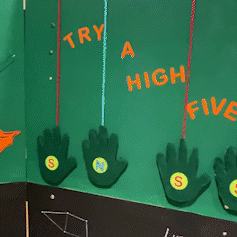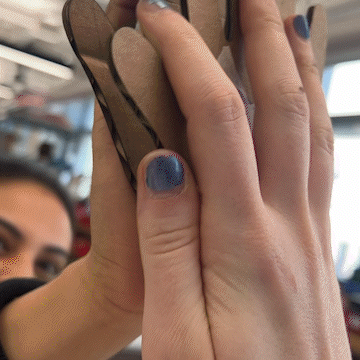MAGNETS!
An Interactive Educational Installation
Collaborators: Dipika Titus & Junru Chen
OBJECTIVE: Teach the learner about the basics of magnets & magnetic force, and show that larger magnets = larger magnetic force.
SECTION 1: INTRODUCE THE CONCEPT
The left-most panel of our section was used to show the title of the installation, and introduce the basic concepts of mangetism.
SECTION 2: GO FISHING
This goal of this section is for the learner to see that the larger the magnet (or stack of magnets in this case), the more paperclips they are able to hold, because there is more of a magnetic pull. To show this, we attached 3 stacks of magnets, one small, one medium, and one large, for the learner to continue the chain of paperclips, to try and reach the fish lower down on the board.

SECTION 3: TRY A HIGH FIVE
The goal of this section is for the learner to see how attraction & repulsion work in practice. To achieve this, we inserted magnets into a felt hands, attached them to pieces of string, and indicated whether they were North or South poles, using the same colors and fonts from Section 1. The two hands on the left are opposing poles, so they attract, while the two hands on the right are the same, so they repulse each other.

USER TESTING:
Two second graders and one 5th grader came in to check out our installation
Learner #1 (2nd grader)
-
Expressed interest in science and desire to be a scientist when she gets older.
- Section 1: Expressed that she already knew the concept of attraction, but not repulsion. Said that she has a magnetic lamp at home, so she knows how magnets attract other magnets
- Section 2: Spent the most time on this section. Needed a little instruction on how to attach the paperclips, but once she was shown, she delicately placed a few on each magnet. Expressed that she saw how you can put more paperclips on the magnet chain coming from the larger stack of magnets. She seemed like she enjoyed playing with putting paperclips on different sides of the magnets to see how that would work. It looked like she had fun making different designs out of paperclips on the magnet stacks (like a flower) once she had gotten the concept down.
- Section 3: It wasn’t immidiately clear to her to hold a felt hand in each hand and have them high five each other, but once she was shown how it worked, she exclaimed that the set on the left (the one with opposing magnets) shows attraction. She spent some time trying to get the pair of hands on the right (with the same side of magnets) to touch in the center, before seeing that it would not work because they are the same type facing each other. She asked questions about how we got the magnets into the felt and how we constructed the hands.

Learners #2 & #3 (2nd grader & 5th grader; siblings)
-
Section 1: Did not spend time in this section or comment on it
- Section 2: Spent the most time in this section. Once Dipika demonstrated how it worked, they spent a few minutes carefully attaching paperclips to each other. They were both able to add more than my groupmates and I were able to when we tested it out. They worked patiently and deliberately.
- Section 3: They put the attraction hands together easily, and when they noticed that the other two hands did not go together, they turned one of the hands around so that they attracted each other.
PROCESS
Painting our section of the boards / using laser-cut letters & shapes out of paper.


